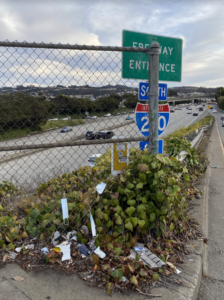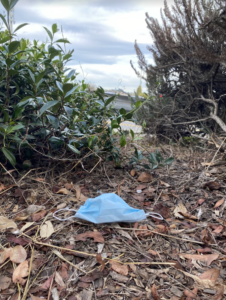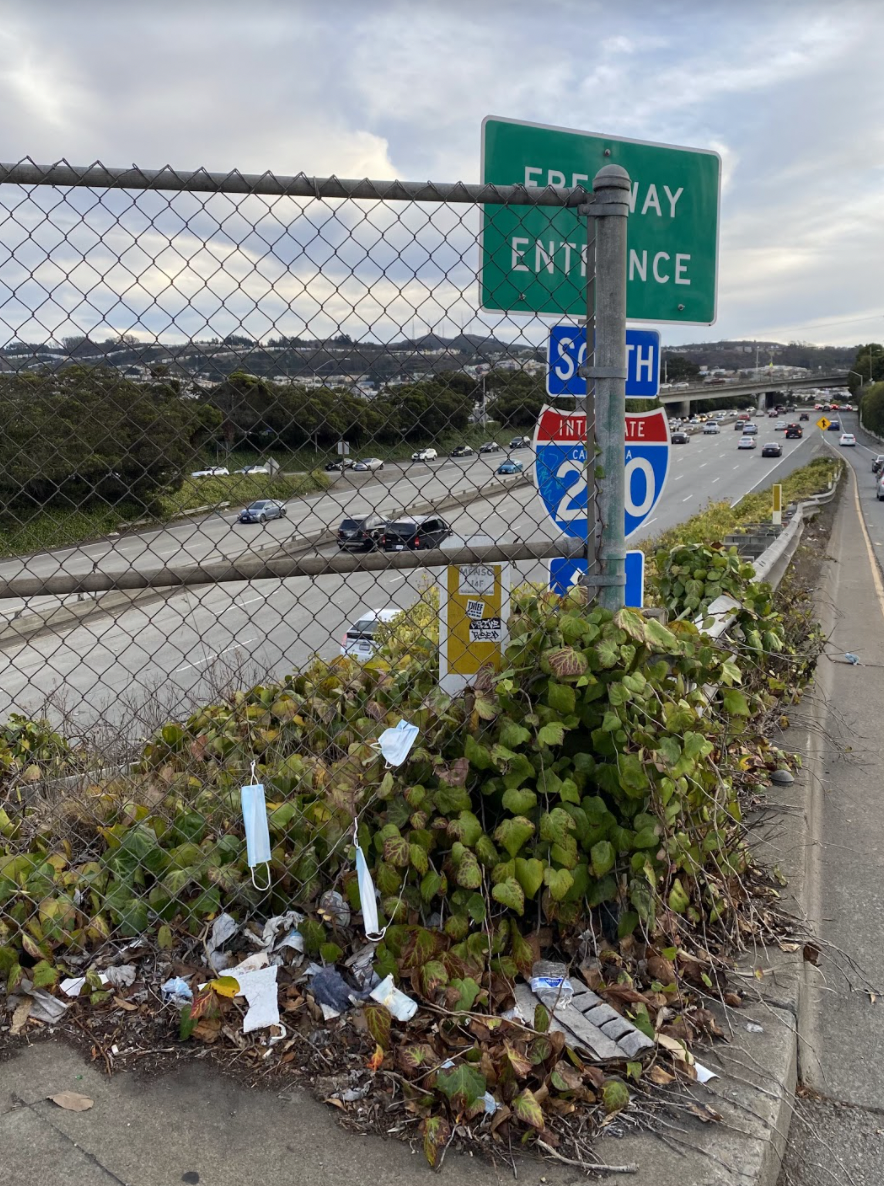The 2020 COVID-19 outbreak initiated a closure of major pollution contributors such as factories, social establishments and transportation. But was that enough to mitigate the climate crisis? During the initial lockdown, greenhouse gas emissions began dropping. However, another environmental pollutant has increased dramatically.

Photo by Ava Ciersi
The increase of disposable face masks and other personal and protective equipment (PPE) thrown out has hit an all time high. In the Bay Area, masses of disposed protective gear have made a drastic environmental impact.
Kate Peterson ’22 a co-leader of the Zero Waste club at Lick-Wilmerding High School has noticed this uptick in her own community.
“I live in Sausalito, which has a big harbor, and I see masks all along the shorelines, gloves and bags all over the place…. I recognize that shade of blue everywhere,” said Peterson.
Up until 2020, studies showed most litter to be cigarette butts, wrappers and straws. In 2020, PPE had become the twelfth most common category of waste pollution, according to a study by the California Coastal Commission. This was the first time items such as masks had ever reached a high enough accumulation to earn their own category on the list.
The California Coastal Commission, a state government organization, conducts a yearly beach cleanup along the 840 miles of the California coastline. During the month-long cleanup in 2020, around 70,000 pounds of trash was reported collected, with 75 percent being plastic. Scientists estimate that some of the plastics used in the protective gear will take over 400 years to decompose.
Pollution rates have continued to escalate in the on-going pandemic. Last year, a study by the American Chemical Society, a scientific research group, found that 129 billion face masks and 65 billion gloves were being used monthly around the world.
These materials are carelessly disposed of by individuals and communities. Masks are littered along roadways, parking lots and everywhere around the city.
In the rainy season, masks and other PPE immediately made their way into creeks and bays. In Northern California, areas such as Tiburon and Pacifica report excessive trash along their shorelines, much of it is PPE being used during the pandemic.
Other organizations such as Project Aware, the largest diving non-profit in the world, have reported similar findings of debris resulting from the pandemic. Jack Fishman, the community conservation coordinator for Project Aware, oversees monitoring data intake for the nonprofit. He collects data from volunteering divers and helps analyze the findings they report.
Fishman said, “Even though it [COVID debris] isn’t an official item on our data list of types of debris, people are actually making the effort to write it in and tell us what they’re finding specifically in the terms of COVID debris.”

Photo by Ava Ciersi
Masks, gloves and sanitizing wipes clog waterways and flow into the oceans, causing large marine mammals to get tangled in the PPE and posing a large threat to marine life. Even in the San Francisco Bay, fish and mammals constantly consume these plastics, corrupting the food chain. The chemicals flowing through storm drains raise countless struggles for different species of fish and plants, destroying habitats, reducing oxygen and targeting various organs within bay animals.
Aside from harming marine life, this surge of PPE also clogs storm drains and harms drinking water systems. After years of trying to block the Bay from pollution, the SF Bay Regional Water Quality Control Board enforced guidelines in fining organizations for their failure to limit trash flow.
For over ten years, the Bay Area communities have maintained a goal of reducing waste and purifying the Bay. However, the pandemic posed a threat to this goal.
The surge of trash merged with pandemic-related budget cuts have created a roadblock in the water board’s plan to achieve zero storm drain pollution by 2022. The pandemic is also affecting organizations such as the California Coastal Commission, Adopt-a-Highway, and Adopt-a-Drain’s volunteer turnouts which have been dropping drastically.
As she considers Sausalito, the Bay Area, and the present world, Peterson displays a determined mindset to not let the scenario of failure play out. She expresses a desire for each individual to play their part.
“If you’ve been living for a long time with a lifestyle that hasn’t considered zero waste or you’re really used to your routines of getting things from the grocery store, it is hard to break out of those routines, but I don’t think there’s any point in your life where you’re too set in stone in your lifestyle to change that,” she said.
Fishman believes that the COVID-19 pandemic may have had one positive impact on climate change awareness because “the perception and accessibility of how we view the world has changed.”
But will we change or revert back to our old habits? Unfortunately, the post-quarantine economic boom has already nullified the decreased air pollution during the initial stay-at-home order. The International Energy Agency predicted that carbon dioxide emissions will increase by 1.5 billion tons this year, the second largest year-on-year increase ever recorded. Carbon dioxide emissions are predicted to rise 5 percent over 2020 levels, the highest rise in a year since 2010. Against popular belief, this rise will almost entirely counter the recent drop, reversing all hope that COVID positively impacted the climate permanently. Along with greenhouse gases, demand for coal, natural gases and oil are anticipated to increase.
The pandemic has altered the way we all look at the climate crisis and is hopefully a wake-up call for everyone, especially our Bay Area Community.






